History
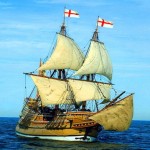 Lately, I have been looking in Ancestry.com, at immigration records for many of my ancestors. As I looked at the different ships they sailed on and the different locations they came from, I began to wonder about what it was really like to immigrate back them. I decided to do some research on that subject, and I was amazed at some of what I found.
Lately, I have been looking in Ancestry.com, at immigration records for many of my ancestors. As I looked at the different ships they sailed on and the different locations they came from, I began to wonder about what it was really like to immigrate back them. I decided to do some research on that subject, and I was amazed at some of what I found.
Of course, the biggest obstacle they faced was the cost…especially for a family. What doesn’t sound like much to us today, was really a lot of money back in the 1800s, and before. My great grandfather, Carl Schuhmacher spent seven years saving the $50.00 that it cost for one person to go. Many times, the whole family would work to send one person over so they could see if the opportunities were really there, and then that person would work t pay for the rest of the family to come.
For people who had to travel in steerage class, the journey was going to be a rough one. There was no limit to the number of steerage tickets sold, and the cost was usually $30.00 per ticket, which tells me that maybe my great grandfather had not traveled in steerage class…which is a relief to me after what I have read. Since there was no limit to the steerage tickets sold, the people were packed into the steerage area like cattle. The cost to feed each one was about sixty cents a day, so they could potentially make a net profit of $45,000 to $60,000 for each crossing. This was money made at the expense of the health, welfare, and even lives of those steerage passengers…a fact that I find shocking to say the least!!
Even when the immigrant wasn’t in steerage, the rough weather often made everyone sick. I don’t think that ships back then had some of the stabilizing features ships have today, and since they were smaller, they were probably tossed around more. Not good if you get sea sick…or even if you normally don’t.
Immigrants were told to be at the docks a day ahead of the departure date, because they had to be examined by American doctors before they were allowed to board the ship. I have no idea where they waited if they didn’t get examined the day before they sailed. I also have to wonder if they had to be examined again when they arrived here, because so many of them were sick on the ship that I would still think they brought disease to America.
Arrival in America didn’t necessarily mean they were set either. Because of language differences and strange sounding names, they were often subject to verbal abuse and discrimination. To fit in they would need to learn 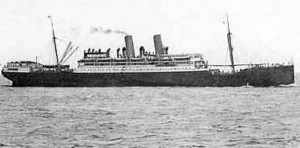 English…something I do agree with, although I don’t agree with discrimination or verbal abuse…or any other kind of abuse. I think they needed someone to teach them, without belittling them. Most wanted to fit in, but didn’t know how to learn English, or simply didn’t have a way to learn it.
English…something I do agree with, although I don’t agree with discrimination or verbal abuse…or any other kind of abuse. I think they needed someone to teach them, without belittling them. Most wanted to fit in, but didn’t know how to learn English, or simply didn’t have a way to learn it.
Any time you make a decision to move to another country, it is a life changing decision, but in those days, it was a much bigger change than it is these days. Had it not been for necessity, due to famine and poverty in their ow country, I have to wonder just how many people would have taken the risk.
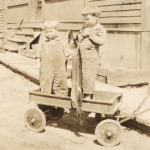 As a young boy, my uncle, William Malrose Spencer II “Uncle Bill” remembers his mother, Anna Schumacher Spencer talking about That Black Book. The way she spoke about it must have made him understand that somehow this book was really important, because he never forgot about it. He called it That Black Book, because his mother had called it That Black Book. He figured that was as good a name as any. Uncle Bill writes, “The year was 1937, and we lived on a farm exactly one half mile West and exactly one half mile North of Holyoke, Minnesota, which was about 20 miles Southwest of Duluth.” He is so meticulous when it comes to the details of the family history…a fact that makes every detail so clear to the reader.
As a young boy, my uncle, William Malrose Spencer II “Uncle Bill” remembers his mother, Anna Schumacher Spencer talking about That Black Book. The way she spoke about it must have made him understand that somehow this book was really important, because he never forgot about it. He called it That Black Book, because his mother had called it That Black Book. He figured that was as good a name as any. Uncle Bill writes, “The year was 1937, and we lived on a farm exactly one half mile West and exactly one half mile North of Holyoke, Minnesota, which was about 20 miles Southwest of Duluth.” He is so meticulous when it comes to the details of the family history…a fact that makes every detail so clear to the reader.
The book came to be about the time of World War I, when his dad, my Grandpa Allen Luther Spencer had gone to Arapahoe and Thomas, Oklahoma to visit his Uncle Luther and his Uncle Cornelius “Neal” and their families.  The uncles had homesteaded in the area in 1895. When he came back, he brought with him the family historical information that Grandma Anna Schumacher Spencer filled the first seven pages of That Black Book with. Uncle Bill believes that most of the information came from his Great Uncle Luther, and then recalls that it was at that time that his own interest in the family history started…never to end.
The uncles had homesteaded in the area in 1895. When he came back, he brought with him the family historical information that Grandma Anna Schumacher Spencer filled the first seven pages of That Black Book with. Uncle Bill believes that most of the information came from his Great Uncle Luther, and then recalls that it was at that time that his own interest in the family history started…never to end.
Being a very meticulous man, who checked his facts as carefully as possible, Uncle Bill became a little frustrated when it appeared that there were errors in the information found in That Black Book. Of course, the only error was that in writing down the history, Christopher Spencer’s father was listed as his brother, making the birth years look like an impossibility. Uncle Bill is a smart man, however, and he figured that problem out right away. As I said, he was meticulous. He just couldn’t let a situation rest until he fixed the error in it. The really amazing thing about that is that he did his fixing without the benefit of a computer and the internet. His 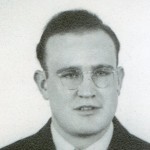 work always involved trips to different places to spend hours going through archives in libraries and government records offices.
work always involved trips to different places to spend hours going through archives in libraries and government records offices.
While That Black Book did contain errors, it really served its main purpose anyway, in that it peaked the interest of a young boy with an amazing amount of determination. Through the years Uncle Bill would build on, correct, and give away copies of the family history to any and all of his relatives who were interested. He is responsible for many additional family historians coming up the ranks in the family, myself included. And it all started when a little boy became interested in the family history information contained in That Black Book.
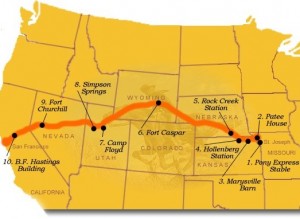 I often wonder how it must have felt to live in a time when so many things were changing in ways that man had not seen before. Things like the automobile, the airplane, the light bulb, the telephone, and the telegraph, all came into being between the 1800s and the early 1900s. Prior to these things, our world was rather primitive concerning things like travel, communication, and even the home life…at least by today’s standards, anyway.
I often wonder how it must have felt to live in a time when so many things were changing in ways that man had not seen before. Things like the automobile, the airplane, the light bulb, the telephone, and the telegraph, all came into being between the 1800s and the early 1900s. Prior to these things, our world was rather primitive concerning things like travel, communication, and even the home life…at least by today’s standards, anyway.
When families began moving West to find land and adventure, it was often a very sad time, because many of these people would not see their loved ones again. They might not even hear from them. This really seemed like an unacceptable situation for most of the people on both sides of that spectrum. The people needed to hear from their loved ones, and so like every other idea, from necessity came a solution…the Pony Express. Prior to the Pony Express, people might try to send a letter with a wagon train heading West to see of they could manage 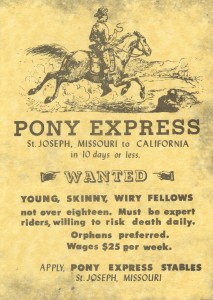 to get it to a loved one who had left a year or more before. Imagine the impossibility of that feat. The person with whom the letter was sent, might not even know the person to whom the letter was being sent. It meant asking around in the area they had planned to settle in, and if they had moved elsewhere…well that is the real definition of the dead letter.
to get it to a loved one who had left a year or more before. Imagine the impossibility of that feat. The person with whom the letter was sent, might not even know the person to whom the letter was being sent. It meant asking around in the area they had planned to settle in, and if they had moved elsewhere…well that is the real definition of the dead letter.
The Pony Express became the first dedicated postal service ever, on this day, April 3, 1860, but it was a far cry from the mail service of today, about which many of us complain. The men who chose to be Pony Express riders had to be told about what they might be riding into. There were Indians, who did not like the White Man. Treaties had been broken, and the White Man was considered an intruder on Indian land. To say that the White Man was not welcome in the West, was putting it mildly. Every time the Pony Express rider set out, he was taking on the risk of never coming back. The Help Wanted posters clearly stated the dangers, and the riders had to be single young men preferably under eighteen and preferably orphans!! Not a glowing help wanted ad, for sure, still there was a need, and these brave men took the challenge and made it work. The Pony Express was a short lived phenomenon, however, lasting just eighteen short months. I suppose something had to be done to make mailing a letter safer. At the point when the last Pony Express rider rode his route, the telegraph had somewhat 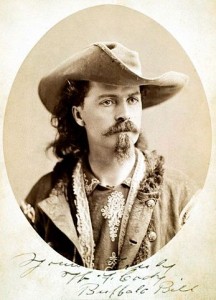 taken its place. Most what had been needed was to be able to let people about the death of loved ones and other urgent or important news, so it seemed like an unnecessary risk to place on these men, when a safe way had been found.
taken its place. Most what had been needed was to be able to let people about the death of loved ones and other urgent or important news, so it seemed like an unnecessary risk to place on these men, when a safe way had been found.
The first Pony Express rider to make the run has been a matter of dispute, but historians have narrowed it down to Johnny Fry or Billy Richardson. James Randall was credited with being the first Eastbound rider, heading out from San Francisco to Sacramento, and William (Sam) Hamilton took the mail from there to the Sportsman Hall Station, where he handed it off to Warren Upson. Other riders were Gus and Charles Cliff, Robert Haslam, Jack Keetley, Billy Tate, and the famous William Cody, known to most of us as Buffalo Bill. Together, these men rode into history as some of the bravest men who ever lived. Riding alone through dangerous territory, risking their lives to make life a little easier for the ever expanding nation we lived in.
 April Fools’ Day has been around for a long time. In 1700 English pranksters popularized the tradition of playing practical jokes on each other. Some people say that it actually started in 1582 when France switched from the Julian calendar to the Gregorian calendar, as mandated by the Council of Trent in 1563. At that point, people who didn’t get on board with the change, and continued to celebrate the new year during the last week of March through April 1, were laughed at and made fun of, as being gullible.
April Fools’ Day has been around for a long time. In 1700 English pranksters popularized the tradition of playing practical jokes on each other. Some people say that it actually started in 1582 when France switched from the Julian calendar to the Gregorian calendar, as mandated by the Council of Trent in 1563. At that point, people who didn’t get on board with the change, and continued to celebrate the new year during the last week of March through April 1, were laughed at and made fun of, as being gullible.
When I was a kid, my sisters and I took great pleasure trying to fool each other. We tried everything from saying they had a spider in their hair to switching the salt and sugar in the containers. Most of the time they were not fooled, but every once in a while, we were rewarded with a completely shocked sister, or even one who screamed. Historians mentioned things like dressing up in disguises or even that the weather got involved in the whole thing, by the unpredictability of the changing season. I think most of us have been fooled by that one, because we dress warmly in the morning and find ourselves too hot later on, or vise versa. Of course, the weather never sticks to just one day.
During the 18th century, April Fools’ Day spread throughout Britain. In Scotland the tradition became a two-day event, starting with “hunting the gowk,” in which people were sent on phony errands. Gowk is a word for cukoo bird, which is the symbol of a fool. The second day was Tailie Day, which involved pranks played on people’s derrieres, such as pinning fake tails or “kick me” signs on them. I’m beginning to think my sisters and I weren’t very inventive.
These days people have really ramped up the process by using newspapers, radio, TV stations, and web sites to report outrageous fictional claims to fool their audiences. According to History.com, “In 1957, the BBC reported that Swiss farmers were experiencing a record spaghetti crop and showed footage of people harvesting noodles from trees; numerous viewers were fooled. In 1985, Sports Illustrated tricked many of its readers when it ran a made-up article about a rookie pitcher named Sidd Finch who could throw a fastball over 168 miles per hour. In 1996, Taco Bell, the fast-food restaurant chain,  duped people when it announced it had agreed to purchase Philadelphia’s Liberty Bell and intended to rename it the Taco Liberty Bell. In 1998, after Burger King advertised a “Left-Handed Whopper,” scores of clueless customers requested the fake sandwich.”
duped people when it announced it had agreed to purchase Philadelphia’s Liberty Bell and intended to rename it the Taco Liberty Bell. In 1998, after Burger King advertised a “Left-Handed Whopper,” scores of clueless customers requested the fake sandwich.”
People are gullible, and some people have a mind that can easily come up with outrageous things. If you are the former type of person, today is going to be a day filled with pranks, because gullible people are well known to those who play on that gullibility. And if you are that prankster, today is your day. Happy April Fools’ Day!! Let the pranking begin, and the gullible people beware!!
 When a United States president is assassinated, it sends shock waves around the world. When one is shot and lives, it sends waves of shock too…and then relief. I was a little girl when John F Kennedy was shot and killed on November 22, 1963, and I will never forget where I was when I found out about it. At the tender age of just seven years, I don’t really think that I fully understood the gravity of the situation. When President Ronald Regan was shot in the chest, on March 30, 1981, I was a married twenty five year old mother of two daughters, and I fully understood the gravity of the situation, and how it could have affected our nation and the world. It was however, the reason he was shot that totally baffled me. I mean, I know what John Hinkley Jr’s deranged reasons were, but it still made no sense to me…especially that he would think that somehow he would win Jodie Foster’s love by shooting the president. I suppose that is simply how the deranged mind works.
When a United States president is assassinated, it sends shock waves around the world. When one is shot and lives, it sends waves of shock too…and then relief. I was a little girl when John F Kennedy was shot and killed on November 22, 1963, and I will never forget where I was when I found out about it. At the tender age of just seven years, I don’t really think that I fully understood the gravity of the situation. When President Ronald Regan was shot in the chest, on March 30, 1981, I was a married twenty five year old mother of two daughters, and I fully understood the gravity of the situation, and how it could have affected our nation and the world. It was however, the reason he was shot that totally baffled me. I mean, I know what John Hinkley Jr’s deranged reasons were, but it still made no sense to me…especially that he would think that somehow he would win Jodie Foster’s love by shooting the president. I suppose that is simply how the deranged mind works.
In the years that the United States has been a nation, sixteen assassination attempts on our presidents. Of those, there have been four successful Presidential assassinations. They were Lincoln, Garfield, McKinley, and Kennedy. I really never thought there might have been that many attempts, but I can see that people get distraut with how things are going, and if they are at all unstable, they might attempt to shoot the president.
President Reagan’s shooting was probably one of the most strange, because he appartently didn’t feel the .22 caliber bullet that entered his chest, narrowly missing his heart, and hit his lung. There were three attendants with him, who were also hit. They were White House Press Secretary James Brady, Secret Service agent Timothy McCarthy, and DC police officer Thomas Delahaney. Hinkley was then overpowered and pinned against a wall. Reagan was shoved into the car and taken to the hospital for treatment. He made a complete recovery, which was amazing, considering that he was 70 years old at the time. He even insisted on walking into George Washington University Hospital under his own power. He was in good spirits and visiting with his wife, Nancy while waiting for surgery. He laughingly said, ”Honey, I forgot to duck,” and to his surgeons, “Please tell me you’re Republicans.”
The next day, he resumed some of his executive duties and even signed a piece of legislation from his hospital bed. He returned to work at the White House on April 11, 1981. He returned even more popular that he already was, and received a hero’s welcome by Congress. His highly successful economics plan was passed with several Democrats breaking ranks to back his plan. Nevertheless, President Reagan felt the effects of the shooting for years afterward. The other men eventually recovered, but James Brady suffered permanent brain damage and later became an advocate for the “Brady Bill” requiring a five day waiting period and background checks before the purchase of a gun, which was signed into law by President Bill Clinton. John Hinkley received a verdict of “not guilty by reason of insanity” bringing with it outrage among the people of this nation. He has been incarcerated at Saint Elizabeth’s Hospital since that time, but more recently has been allowed supervised home visits with his parents. I suppose that one day, he could be released, since they have said that his mental illness is in remission.
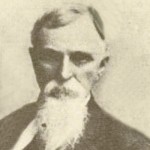 When I first read about the six Knox brothers who were able to place themselves into a family history where they belonged, but in which no one had been able to connect them to before, I was intrigued, for sure. They seemed so resourceful, but I had a feeling that there was a lot more to them than just finding their place in the family history. I’m sure I will come back to these brothers over and over in the future, but when I read about Dr Nicholas C Knox, I was…well, amazed really. This man had the character and fortitude to overcome adversity, and move forward with his life, and in the end, make it better.
When I first read about the six Knox brothers who were able to place themselves into a family history where they belonged, but in which no one had been able to connect them to before, I was intrigued, for sure. They seemed so resourceful, but I had a feeling that there was a lot more to them than just finding their place in the family history. I’m sure I will come back to these brothers over and over in the future, but when I read about Dr Nicholas C Knox, I was…well, amazed really. This man had the character and fortitude to overcome adversity, and move forward with his life, and in the end, make it better.
The fourth son of Absalom Knox MD, Nicholas married Henrietta Craigan. After their marriage, the civil war slammed its way into the midst of their lives. Nicholas enlisted in the Seventeenth Mississippi Regiment, which was commanded by Colonel WS Featherstone, and was a part of McLaw’s Division. Nicholas took part in all the great battles in the Army of Virginia in which his command was engaged, but it was the Battle of Gettysburg that would change his life forever. On the second day of the battle, Nicholas lost his right arm. To make matter worse, he was captured and confined as a prisoner on Hart Island, off the city of New York, for several months before being parolled and sent into the Confederate lines again…without his right arm, and he managed to stay alive during the remainder of the battles he fought in.
During his entire enlistment time in the Civil War, Nicholas was never home…until the day he was discharged. I don’t know if he had been able to tell his wife about his arm, but even if he did, there is nothing like actually seeing it for the first time. It had to be hard for her…and for him. Many soldiers coming home from wars with life changing injuries feel very concerned about just how their spouse will look at them now. They feel like they are a lesser person than they were when they left, and that is just the physical challenges. I’m sure that an injury that cost you your arm, would be a moment that would live in your memory files for the rest of your life.
Nevertheless, Nicholas was not a man to let adversity take his life or his future from him. He returned to Mississippi, and he started the task of rebuilding his life, and getting reacquainted with his family. He started out by teaching school. Now most people would think that was a noble profession, and they would be right, but 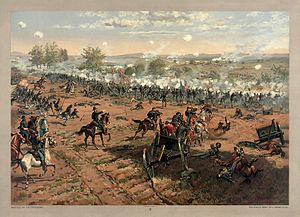 it was not enough for Nicholas. While teaching school, he began to study medicine, and received a diploma from a medical college at Nashville, Tennessee. When I think about the challenges of being a doctor in post Civil War America, with only one arm, and during a time when prosthetics were primitive at best, I am amazed. Still, Nicholas was not satisfied. He entered politics, and represented his county in the Legislature, and afterward was a practitioner of medicine in Reynolds, Mississippi, and he was an elder in the Presbyterian Church. No matter what challenges hit Nicholas, he met them head on, and succeeded in every endeavor he took on. He was not a man content to settle on the ordinary. He was truly an amazing man.
it was not enough for Nicholas. While teaching school, he began to study medicine, and received a diploma from a medical college at Nashville, Tennessee. When I think about the challenges of being a doctor in post Civil War America, with only one arm, and during a time when prosthetics were primitive at best, I am amazed. Still, Nicholas was not satisfied. He entered politics, and represented his county in the Legislature, and afterward was a practitioner of medicine in Reynolds, Mississippi, and he was an elder in the Presbyterian Church. No matter what challenges hit Nicholas, he met them head on, and succeeded in every endeavor he took on. He was not a man content to settle on the ordinary. He was truly an amazing man.
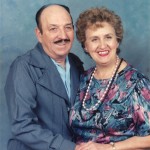 As we were going through our parents things after the passing of our mother, we came across several very old maps of different states, and also one that I received of London during World War II. It occurred to me that my sisters and I are a real novelty these days, in that we know how to read a map, and plan out a route to travel to anywhere we would like to go. I’m sure there are other people out there who can read maps too, but in this day and age of the GPS, many people can’t either. I’m all for technology, and I have a GPS myself, but I can also read a map, and that is because of my dad, and his determination to teach us that art.
As we were going through our parents things after the passing of our mother, we came across several very old maps of different states, and also one that I received of London during World War II. It occurred to me that my sisters and I are a real novelty these days, in that we know how to read a map, and plan out a route to travel to anywhere we would like to go. I’m sure there are other people out there who can read maps too, but in this day and age of the GPS, many people can’t either. I’m all for technology, and I have a GPS myself, but I can also read a map, and that is because of my dad, and his determination to teach us that art.
Every year our family would take a vacation. Sometimes we didn’t travel very far, like the year we took a Wyoming tour, in several separate legs over the course of two weeks. Other times, we traveled quite a ways, like the years we went to visit our sister, Cheryl Masterson, while she was living in upstate New York. As students go, we were a novelty too, because every year when the teacher asked the inevitable question about what we did over the summer, we always had a story to tell. At the time, we didn’t 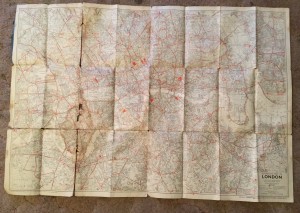 realize just how blessed…and how traveled we were, compared to other students in class. I always thought that everyone took a vacation, but that isn’t so. Many kids got to go visit a grandparent or some other relative, but going to the same place every summer isn’t really a vacation.
realize just how blessed…and how traveled we were, compared to other students in class. I always thought that everyone took a vacation, but that isn’t so. Many kids got to go visit a grandparent or some other relative, but going to the same place every summer isn’t really a vacation.
Our parents were so excited about our vacations every year, and we would often sit down and Dad would show us the route we were going to take on our trip. It was during these vacation planning sessions, that we learned to read a map, and that we learned to enjoy reading a map. The map was never confusing or complicated to us, because Dad showed us how to read it. We knew the difference between an interstate and a state highway. We knew how to pick out the larger cities, as opposed to the small towns. We knew what states and what towns we would be traveling through, and we knew how to find the sights that were located in the area that might be of interest. We knew how to find campgrounds in the area, and how to figure out how far we could easily travel in a days time. All these things are on a map, if you know where to look for them, and thanks to our dad, we did.
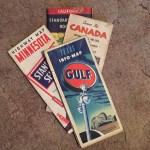
I suppose that many people wouldn’t think of a map as a treasure, but for my sisters and me, they really were. We all had to have some of them, and every time we look at them, they will serve as a reminder of those planning sessions, and of all those amazing vacations we took as kids, with our parents. I have no problem with the convenience of a GPS, and in the big cities my husband Bob and I travel to, they are a great help, but if my GPS ever failed, I could still get us there with a map. It is a legacy that our dad left for his daughters. It does make us a novelty, but it is something we are all proud to be able to do, and thankful that we had the parents we had. Their interest in travel, and Dad’s teachings on maps clearly enriched our lives.
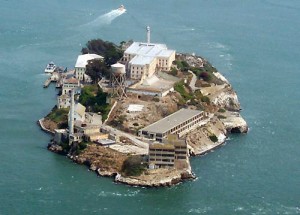 On a trip to San Francisco, my husband, Bob and I took a tour of Alcatraz Prison. I expected it to be a usual touristy place, even though it had been the nation’s end of the line maximum security prison. It was where they sent the most incorrigible inmates. When we arrived, the island known as The Rock or America’s Devil Island to the inmates who did time there, really looked more like an industrial island than a prison, but you could see why it was called The Rock. Of course, that first view of the island was the last time I thought it didn’t look like a prison.
On a trip to San Francisco, my husband, Bob and I took a tour of Alcatraz Prison. I expected it to be a usual touristy place, even though it had been the nation’s end of the line maximum security prison. It was where they sent the most incorrigible inmates. When we arrived, the island known as The Rock or America’s Devil Island to the inmates who did time there, really looked more like an industrial island than a prison, but you could see why it was called The Rock. Of course, that first view of the island was the last time I thought it didn’t look like a prison.
Upon stepping inside, you felt an immediate, almost claustrophobic sensation, and I’m not claustrophobic. The cells were often painted black inside. It was a way of achieving privacy for the inmate. To me it just seemed bleak. I could imagine how it must have been…knowing that you could not leave this dark and ominous place. Alcatraz operated from the mid 1930s to the mid 1960s, and housed over 200 inmates. Well known for it’s brutal conditions, Alcatraz was thought to be inescapable due to the frigid waters of the bay. One group of prisoners either died or proved the rumors wrong, when they escaped and were never heard from again. Their fate is still unknown. The prisoners had to comply with very strict rules, and were required to live in complete silence. The first metal detectors were used at Alcatraz. No wonder the prisoners considered escape, knowing it meant almost certain death. Eventually, the conditions and treatment of the prisoners were deemed cruel and unusual punishment, and on March 21, 1963.
First explored by Juan Manuel de Ayala in 1775, it was originally called Isla de los Alcatraces, which meant 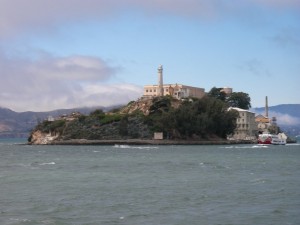 Island of the Pelicans. It was sold to the government in 1849. The first lighthouse in California was on Alcatraz. It was once a Civil War fort and then a military prison in 1907. Finally it became the maximum security prison known as The Rock. After it’s closing, a group of Sioux Indians claimed that the island belonged to them due to a 100 year treaty. Those claims were ignored until November of 1969 when a group of Native Americans representing the American Indian Movement, or AIM occupied the island. They stayed until 1971 when they were finally forced off of the island by federal authorities. The next year it was added to the Golden Gate National Recreation Area and opened for tourism. It was a very interesting tour to say the least.
Island of the Pelicans. It was sold to the government in 1849. The first lighthouse in California was on Alcatraz. It was once a Civil War fort and then a military prison in 1907. Finally it became the maximum security prison known as The Rock. After it’s closing, a group of Sioux Indians claimed that the island belonged to them due to a 100 year treaty. Those claims were ignored until November of 1969 when a group of Native Americans representing the American Indian Movement, or AIM occupied the island. They stayed until 1971 when they were finally forced off of the island by federal authorities. The next year it was added to the Golden Gate National Recreation Area and opened for tourism. It was a very interesting tour to say the least.
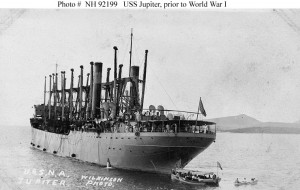 Following the first successful airplane flight by the Wright brothers on Dec 17, 1903, the world changed dramatically…as did the way we fought wars. Of course, just because the Kitty Hawk broke free of the gravitational pull of Earth on that day, did not mean that we went straight to jets. Nevertheless, by the 1920s, airplanes were more common. With this change in travel and maneuverability, came the ability to use these new weapons in warfare. While it took time to develop airplanes to the ability needed to use in a war, in all reality, warfare was forever changed on that day.
Following the first successful airplane flight by the Wright brothers on Dec 17, 1903, the world changed dramatically…as did the way we fought wars. Of course, just because the Kitty Hawk broke free of the gravitational pull of Earth on that day, did not mean that we went straight to jets. Nevertheless, by the 1920s, airplanes were more common. With this change in travel and maneuverability, came the ability to use these new weapons in warfare. While it took time to develop airplanes to the ability needed to use in a war, in all reality, warfare was forever changed on that day.
The United States quickly became interested in aerial warfare, and began work on developing the planes and providing training for the pilots who would fly them. In August of 1910, Jacob Earl Fickel did the first experimenting, with Glenn Curtiss shooting a gun from an airplane. At that time, planes couldn’t easily fly across oceans like they can now, so if they were to be used in warfare, they would have to be transported to the war zone somehow. That brought about the expirements to see if it was practical to take off and land on a ship. I have to wonder just how many failed attempts they had before civilian pilot Eugene Ely successfully took off from a wooden platform installed on the scout cruiser USS Birmingham on November 14, 1910 near Hampton Roads, Virginia. This exceptional pilot successfully took off, and then landed safely on shore a few minutes later. Several months later on January 18, 1911, he also successfully landed on a platform on the USS Pennsylvania in San Francisco harbor.
Now that they knew it could be done, it was time to find a ship to be the carrier full time. Enter the USS Jupiter. The USS Jupiter was a collier ship, which is a bulk cargo ship, from 1913 to 1920. At that point, it was 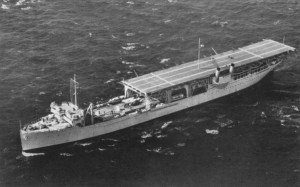 decided that the USS Jupiter would be decommissioned, and converted into the first aircraft carrier in history. Once the work was finished, the USS Jupiter became the USS Langley on April 11, 1920 and was recommissioned as an aircraft carrier on March 20, 1922. Her first executive officer felt right at home on the new ship, because Commander Kenneth Whiting, who was a former submarine commander turned aviator, had been transported to England by the collier Jupiter. Whiting, who earned the title “Father of the Aircraft Carrier,” was the last naval aviator to take training personally from Orville Wright…bringing things full circle so to speak…but the story never really ends does, now does it.
decided that the USS Jupiter would be decommissioned, and converted into the first aircraft carrier in history. Once the work was finished, the USS Jupiter became the USS Langley on April 11, 1920 and was recommissioned as an aircraft carrier on March 20, 1922. Her first executive officer felt right at home on the new ship, because Commander Kenneth Whiting, who was a former submarine commander turned aviator, had been transported to England by the collier Jupiter. Whiting, who earned the title “Father of the Aircraft Carrier,” was the last naval aviator to take training personally from Orville Wright…bringing things full circle so to speak…but the story never really ends does, now does it.
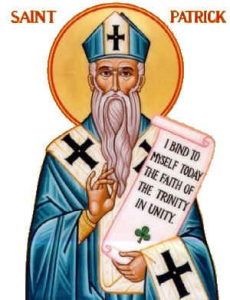 Many holidays get their start on the birth or death of someone famous or very special, and Saint Patrick’s Day is no exception. It was the day that Saint Patrick died in Saul, Ireland. I’m sure that wasn’t surprising to anyone. So, the question then becomes, who was Saint Patrick, and why is he being honored?
Many holidays get their start on the birth or death of someone famous or very special, and Saint Patrick’s Day is no exception. It was the day that Saint Patrick died in Saul, Ireland. I’m sure that wasn’t surprising to anyone. So, the question then becomes, who was Saint Patrick, and why is he being honored?
Saint Patrick was a Christian missionary, bishop, and apostle of Ireland, but that in and of itself was not what made him famous. He lived in a time in history when little would be known of a person’s life if no one took the time to write things down. The Internet, Facebook, and Twitter were far off in the very distant future, so people wrote letters and kept journals. Saint Patrick wrote a book that he titled, “Confessio”, during his last year of life, and it is from these writings that we know what we know of him.
Saint Patrick was born in Great Britain probably in Scotland, to a wealthy Christian family of Roman citizenship. At the age of about 16 years, he was captured be Irish marauders and made to be a slave. For the next six years he worked as a herder in Ireland. Due to the long lonely days, far from family and other human companionship, he drew closer and closer to God for comfort. After hearing a voice in a  dream one night, he escaped and found passage on a ship that took him back to Great Britain and his family. Once he was back with his family, he had another dream. In the dream someone named Victoricus gave him a letter entitled “The Voice of the Irish.” He felt like the Irishmen were pleading with him to go back to Ireland.
dream one night, he escaped and found passage on a ship that took him back to Great Britain and his family. Once he was back with his family, he had another dream. In the dream someone named Victoricus gave him a letter entitled “The Voice of the Irish.” He felt like the Irishmen were pleading with him to go back to Ireland.
In 433, he returned to Ireland, after studying to become an ordained Christian minister and started preaching the Gospel. Thousands of Irishmen were converted to Christianity and many churches were built all around Ireland. After 40 years of devoting his life to God and His work, Saint Patrick died on March 17, 461, in the town of Saul, Ireland, which is where he built his first church.
Since his passing, many legends have grown up about him. He was made the patron saint of Ireland, and 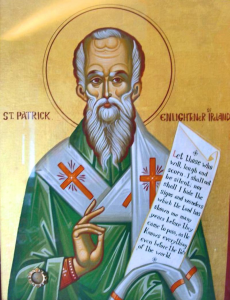 people say that he baptised hundreds of people in a single day. He is also said to have used a three-leaf clover, which became the famous shamrock to describe the Holy Trinity. He is portrayed as trampling snakes because it is said that he had driven them out of Ireland. The Irish observe the day of his passing as a national holiday, attending church in the mornig and celebrating with food and drink in the afternoon. Later the rest of the world jumped on board, and the first Saint Patrick’s Day parade was celebrated in the United States, and involved Irish soldiers serving in the English military marching through the streets of New York City in 1762. The parades became a show of unity and strength for the Irish-American immigrants and the party went global in 1995 when the Irish government started a campaign to matket Saint Patrick’s Day as a way of driving tourists to Ireland. Today, March 17th is still celebrated by millions of people, many of whom probably have no idea what this man stood for. It’s something to think about for sure. Happy Saint Patrick’s Day!!
people say that he baptised hundreds of people in a single day. He is also said to have used a three-leaf clover, which became the famous shamrock to describe the Holy Trinity. He is portrayed as trampling snakes because it is said that he had driven them out of Ireland. The Irish observe the day of his passing as a national holiday, attending church in the mornig and celebrating with food and drink in the afternoon. Later the rest of the world jumped on board, and the first Saint Patrick’s Day parade was celebrated in the United States, and involved Irish soldiers serving in the English military marching through the streets of New York City in 1762. The parades became a show of unity and strength for the Irish-American immigrants and the party went global in 1995 when the Irish government started a campaign to matket Saint Patrick’s Day as a way of driving tourists to Ireland. Today, March 17th is still celebrated by millions of people, many of whom probably have no idea what this man stood for. It’s something to think about for sure. Happy Saint Patrick’s Day!!

